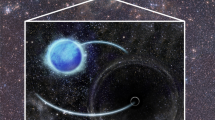Abstract
ONE of the most exciting predictions of the general theory of relativity is that a star of more than about 1.4 M⊙ may undergo gravitational collapse to produce a black hole when it has exhausted its nuclear fuel. It would therefore be a very important confirmation of the theory if such holes could be detected. Unfortunately their very small size (a few km) makes it virtually impossible to observe them directly, but their existence could be inferred from the motion of other objects in their gravitational field. The natural place to look for black holes therefore is in binary star systems in which only one object is observed (single line binaries). Thorne and Trimble1 gave a list of all single line spectroscopic binaries in Batten's2 catalogue in which the mass of the unseen object was estimated to be 1.4 M⊙ or over. In most of these binaries the unseen secondary was less massive than the primary observed star and therefore could have been a normal star which is not observed in comparison with its brighter companion. In a smaller number of cases the secondary was heavier than the primary, but in each of these cases Trimble and Thorne were able to suggest a possible reason why it might not have been observed. They concluded therefore that while some of these single line binaries might contain black holes there was no compelling reason for believing that any of them did.
Similar content being viewed by others
References
Trimble, V. L., and Thorne, K. S., Astrophys. J., 156, 1013 (1969).
Batten, A. H., Pub. Dom. Astrophys. Obs. Victoria, 13, 119 (1967).
Maestre, L. A., and Wright, J. A., Astrophys. J., 131, 119 (1960).
Muller, P., J. des Observateurs, 40, 48 (1957).
Zel'dovich, Ya. B., and Guseynov, O. H., Astrophys. J., 144, 841 (1965).
Tsuruta, S., “The Effects of Nuclear Forces on the Maximum Mass of Neutron Stars” in The Crab Nebula (edit. by Davies, R. D., and Smith, F. G.) (Reidel, Dordrecht, in the press).
Author information
Authors and Affiliations
Rights and permissions
About this article
Cite this article
GIBBONS, G., HAWKING, S. Evidence for Black Holes in Binary Star Systems. Nature 232, 465–466 (1971). https://doi.org/10.1038/232465a0
Received:
Published:
Issue Date:
DOI: https://doi.org/10.1038/232465a0
- Springer Nature Limited
This article is cited by
-
Why relativistic stars avoid binaries
Astrophysics (1975)
-
Physical Sciences: Nature of the Secondary Component of Beta Lyrae
Nature (1972)
-
No Evidence for Black Holes in Eccentric Binary Systems
Nature Physical Science (1972)
-
Black Holes and Gravitational Theory
Nature (1972)
-
Further Evidence for Collapsed Objects in Binary Star Systems
Nature (1971)





